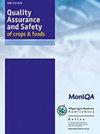Vanillic acid alleviates lipopolysaccharides-induced endoplasmic reticulum stress and inflammation in human lung fibroblasts by `inhibiting MAPK and NF-κB pathways
IF 5.3
3区 农林科学
Q1 FOOD SCIENCE & TECHNOLOGY
引用次数: 4
Abstract
Persistent endoplasmic reticulum stress promotes aberrant inflammation and induces cell death, and inflammation is implicated in the pathogenesis of pneumonia. Vanillic acid exerts pharmacological activities, such as anti-inflammatory, antimicrobial, and antioxidant effects. However, the role of vanillic acid in pneumonia has not been elucidated yet. Human lung fibroblasts (WI-38 and MRC-5) were incubated with different concentrations of lipopolysaccharides to mimic the cell model of pneumonia. Lipopolysaccharides-treated lung fibroblasts were then incubated with different concentrations of vanillic acid. Cell viability and apoptosis were detected by MTT assay and flow cytometry, respectively. Quantitative real-time polymerase chain reaction and enzyme-linked-immunosorbent serologic assay were used to measure the levels of inflammatory factors. Western blot assay was used to detect endoplasmic reticulum stress and downstream pathway. Lipopolysaccharides induced decrease of cell viability in WI-38 and MRC-5 whereas vanillic acid increased cell viability of lipopolysaccharides-treated lung fibroblasts. Lipopolysaccharides-induced increase of cell apoptosis in lung fibroblasts was suppressed by vanillic acid through up-regulation of BCL2, and down-regulation of BCL2 associated X (BAX) and cleaved caspase-3. Vanillic acid reduced levels of tumor necrosis factor-α (TNF-α), Interleukin 6 (IL-6), and IL-1β in lipopolysaccharides-treated lung fibroblasts. Protein expression of glucose-regulated protein 78 (GRP78), X-box binding protein 1 (XBP-1), activating transcription factor-6 (ATF-6), ATF-4, and C/EBP homologous protein (CHOP) in lung fibroblasts were up-regulated by lipopolysaccharides while reduced by vanillic acid. Vanillic acid attenuated lipopolysaccharides-induced decrease of IκBα and increase of p-IκBα, p-p65, p-ERK, and p-JNK in fibroblasts. Vanillic acid exerted anti-inflammatory effect against lipopolysaccharides-induced human lung fibroblasts by inhibiting mitogen-activated protein kinase and nuclear factor kappa B pathways.香草酸通过抑制MAPK和NF-κB通路减轻脂多糖诱导的人肺成纤维细胞内质网应激和炎症
持续的内质网应激促进异常炎症并诱导细胞死亡,炎症与肺炎的发病机制有关。香草酸具有抗炎、抗菌、抗氧化等药理作用。然而,香草酸在肺炎中的作用尚未阐明。用不同浓度的脂多糖培养人肺成纤维细胞(WI-38和MRC-5),模拟肺炎细胞模型。脂多糖处理后的肺成纤维细胞与不同浓度的香草酸孵育。分别用MTT法和流式细胞术检测细胞活力和凋亡。采用实时定量聚合酶链反应和酶联免疫吸附血清学检测炎症因子水平。Western blot法检测内质网应激及下游通路。脂多糖可降低WI-38和MRC-5细胞活力,而香草酸可提高脂多糖处理的肺成纤维细胞活力。香草酸通过上调BCL2,下调BCL2相关X (BAX)和cleaved caspase-3抑制脂多糖诱导的肺成纤维细胞凋亡的增加。香草酸可降低脂多糖处理的肺成纤维细胞中肿瘤坏死因子-α (TNF-α)、白细胞介素6 (IL-6)和IL-1β的水平。糖调节蛋白78 (GRP78)、X-box结合蛋白1 (XBP-1)、活化转录因子6 (ATF-6)、ATF-4和C/EBP同源蛋白(CHOP)在肺成纤维细胞中的表达在脂多糖的作用下上调,在香草酸的作用下降低。香草酸能减弱脂多糖诱导的成纤维细胞中i - κ b α的减少和p- i - κ b α、p-p65、p-ERK和p-JNK的增加。香草酸通过抑制丝裂原活化蛋白激酶和核因子κ B途径对脂多糖诱导的人肺成纤维细胞发挥抗炎作用。
本文章由计算机程序翻译,如有差异,请以英文原文为准。
求助全文
约1分钟内获得全文
求助全文
来源期刊

Quality Assurance and Safety of Crops & Foods
FOOD SCIENCE & TECHNOLOGY-
CiteScore
4.60
自引率
7.50%
发文量
61
审稿时长
1 months
期刊介绍:
''Quality Assurance and Safety of Crops & Foods'' is an international peer-reviewed journal publishing research and review papers associated with the quality and safety of food and food sources including cereals, grains, oilseeds, fruits, root crops and animal sources. It targets both primary materials and their conversion to human foods. There is a strong focus on the development and application of new analytical tools and their potential for quality assessment, assurance, control and safety. The scope includes issues of risk assessment, traceability, authenticity, food security and socio-economic impacts. Manuscripts presenting novel data and information that are likely to significantly contribute to scientific knowledge in areas of food quality and safety will be considered.
''Quality Assurance and Safety of Crops & Foods'' provides a forum for all those working in the specialist field of food quality and safety to report on the progress and outcomes of their research.
 求助内容:
求助内容: 应助结果提醒方式:
应助结果提醒方式:


